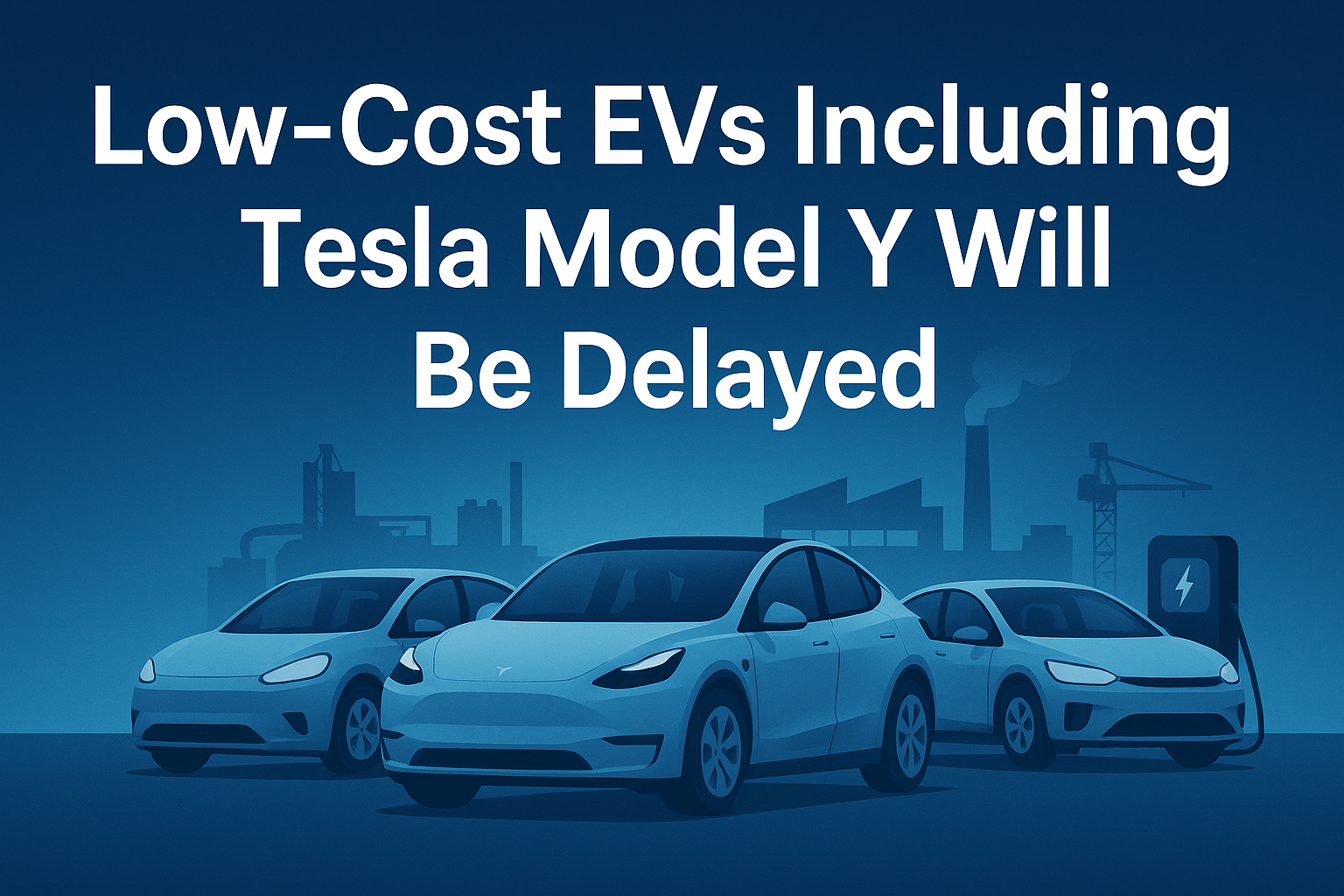Electric vehicles (EVs) were supposed to be the future. Scratch that — they are the future. But that future just got a bit farther away for people hoping to drive one without breaking the bank.
In early 2024, Tesla — the poster child for EV innovation — dropped a bit of a bombshell: their plans for a long-promised, affordable electric vehicle (often dubbed the “$25,000 Tesla”) have been put on the back burner. And it’s not just Tesla. Across the industry, EV projects aimed at making clean driving more accessible are getting hit with delays, rethinks, and even cancellations.
So, what gives? Weren’t we just told the EV revolution was in full swing? Let’s unpack what’s happening, what it means for you, and why we might need to realign our EV expectations — at least for now.
The Dream: Affordable EVs for Everyone
Let’s rewind a bit. For years, Tesla and other automakers have promised a new wave of affordable EVs — sleek, smart cars that would go toe-to-toe with gas-powered vehicles on price and performance. Elon Musk himself talked about a $25,000 Tesla as early as 2020, and many believed that by 2025, we’d see EVs priced for the masses — not just the early adopters or luxury buyers.
These “low-cost” EVs were supposed to do more than just cut emissions — they were meant to democratize clean mobility. Think: students, young families, gig workers, first-time car buyers. A $25K EV would open the floodgates.
But as it turns out, dreams are easier to announce than to build.
Tesla Taps the Brakes
Tesla’s recent shift in strategy came as a surprise to some — but not everyone in the industry. In April 2024, internal reports revealed that Tesla was scrapping or at least delaying its affordable EV program, choosing instead to focus on its upcoming robotaxi platform.
That’s right: rather than building a car that millions could own, Tesla is now prioritizing a vehicle nobody owns — an autonomous ride-sharing fleet. It’s a bold pivot, but one that reflects Tesla’s evolving view of the future.
Elon Musk responded by saying the low-cost EV plan wasn’t dead, just “folded into” the robotaxi project. But many took that as code for: “Don’t hold your breath.”
This means the Tesla Model Y, already one of the company’s most affordable and popular models, might be the last mid-priced Tesla for a while — and any truly budget-friendly models could now be years away.
So, What’s Causing the Delay?
It’s not just Tesla — other automakers are also scaling back or delaying their affordable EV offerings. Here’s why:
1. Battery Costs Haven’t Dropped Enough
Batteries are the single most expensive part of an EV. While prices have come down over the past decade, the pace of that decline has slowed. Raw materials like lithium, cobalt, and nickel are volatile in price and subject to global supply chain drama.
Without cheaper batteries, it’s incredibly hard to produce an EV that’s truly low-cost and profitable.
2. Manufacturing Challenges
Building EVs at scale is a totally different beast from making gas cars. It requires retooled factories, new supply chains, and specialized parts. Automakers are investing billions, but it takes time — and any hiccup (hello, semiconductor shortages!) can slow everything down.
3. Shifting Priorities
Tesla isn’t alone in pivoting to higher-margin products. Ford delayed its EV truck program. GM postponed some of its budget EVs. Why? Because luxury and performance EVs make more money. And in times of economic uncertainty, carmakers tend to protect their profits.
4. Autonomous Tech Is Taking Center Stage
Tesla’s robotaxi push isn’t just a distraction — it’s part of a bigger bet. If full autonomy becomes a reality, it could change car ownership forever. Why make a $25K EV when people might stop owning cars altogether?
What This Means for Consumers
So where does that leave you — the everyday driver who just wants a reliable, affordable EV?
Here’s the deal:
- Sticker shock is still real. Right now, the average EV still costs more than its gas counterpart. Even with federal and state tax credits, you’re likely looking at $35K+ for a decent new EV.
- Used EVs may become more attractive. As first-gen EVs come off leases or get traded in, the used market will grow. This could be the best entry point for budget-minded buyers in the next 2–3 years.
- Charging infrastructure is improving — slowly. One bright spot: governments and companies are investing in better charging networks. So if you do get an EV, it’ll be easier than ever to keep it juiced up.
- EV leasing could offer a workaround. Monthly lease deals on some models (like the Chevy Bolt or Hyundai Kona EV) can sometimes be more budget-friendly than buying — especially when combined with incentives.
Global Perspective: Not Just a U.S. Problem
This affordability crunch isn’t limited to North America.
In Europe, where EV adoption is strong thanks to high fuel prices and tax breaks, even budget-friendly brands like Renault and Volkswagen are struggling to launch truly low-cost models. VW’s much-hyped €25,000 EV won’t hit roads until 2026 or later.
In China, where low-cost EVs like the Wuling Mini EV are thriving, the story is different — but even there, manufacturers are feeling the squeeze of rising material costs and price wars.
Bottom line: unless you’re in a market like China where ultra-cheap micro-EVs are common, the dream of an affordable, high-quality EV is on pause.
What’s Next: A Two-Tier EV Future?
With premium EVs continuing to roll out — think the Tesla Cybertruck, Lucid Air, or Rivian R1T — and low-cost EVs getting delayed, we may be heading into a bifurcated EV world:
- Tier 1: High-end EVs for wealthier consumers, offering luxury, long range, and cutting-edge tech.
- Tier 2: Affordable but basic EVs, possibly smaller and with shorter range, aimed at urban drivers or fleets.
This leaves a big gap in the middle — a space once filled by compact sedans and hatchbacks like the Toyota Corolla or Honda Civic. EVs have yet to fill that niche at scale.
Why This Matters (Even If You’re Not Buying an EV Yet)
You might be thinking, “Well, I’m not in the market for a new car right now anyway.” Fair enough. But the delay in affordable EVs affects everyone.
- It slows climate progress. Widespread EV adoption is essential for cutting transportation emissions. If only wealthy drivers can afford them, that shift takes longer.
- It impacts policy planning. Governments designing incentives and infrastructure around rapid EV adoption now have to recalibrate.
- It shifts automaker priorities. If consumer demand doesn’t match automaker supply, some may back away from EVs entirely, risking the momentum of the transition.
There’s Still Hope
Okay, that was a lot of gloomy news. But let’s not give up on the EV dream just yet.
Innovation hasn’t stopped. Battery breakthroughs (like solid-state tech), modular vehicle platforms, and smarter manufacturing could still unlock the door to cheaper EVs. Companies like BYD, Hyundai, and even Tesla are still working on solutions — they’re just not rolling out as fast as we hoped.
And don’t forget: 10 years ago, EVs were a fringe luxury. Today, they’re everywhere. The leap from $70K Teslas to $25K EVs is just taking a little longer than expected.
Final Thoughts: Patience, Power, and Progress
If you’re one of the many drivers hoping for a low-cost EV in 2025, this news might sting. But it doesn’t mean the vision is dead — just that we’ll need a bit more patience.
In the meantime, the best thing you can do is stay informed, consider your options (including hybrids and used EVs), and keep an eye on emerging tech. The revolution is still coming — it’s just stuck in traffic for a little while longer.




It’s disappointing but not totally surprising — the infrastructure, supply chain, and tech all still seem to be catching up with the hype around EV accessibility. It feels like the vision was a bit ahead of what the industry can realistically deliver right now.
Interesting breakdown. I hadn’t considered how much these delays might impact people like gig workers or students who were banking on a budget-friendly EV. It really highlights how access to clean transportation is still a luxury for many.
You nailed it with the idea of realigning expectations. A lot of us assumed that tech breakthroughs would automatically translate to affordability, but it’s clear now that scaling clean mobility is going to be more complex and incremental than we hoped.
I think it’s important to recognize that these delays aren’t necessarily a bad thing for the overall EV industry. Maybe it’s better to take the time to get the technology right, but it definitely raises questions about how soon the EV market can really be for everyone.
This really highlights the gap between EV hype and real-world accessibility. Affordability isn’t just about the sticker price — it’s about long-term costs, charging infrastructure, and whether everyday drivers can realistically make the switch.
It’s not surprising to see delays given the challenges of scaling production and lowering costs. The EV market is at a crossroads, and it’ll be interesting to see if companies like Tesla can overcome these growing pains without losing sight of affordability.
This delay seems like a step back for EV accessibility, but maybe it’s a chance to re-evaluate what true affordability in this space should look like — not just the sticker price, but long-term ownership costs too. There’s still a lot of room for innovation in how we define value in the EV market.
The post brings up an important point — low-cost EVs weren’t just about tech; they were about accessibility. With these delays, we risk widening the gap between eco-friendly transport and those who need it most.
Reading this, I’m wondering how these delays might affect overall EV adoption rates. If lower-cost options are shelved, are we at risk of clean mobility becoming a luxury rather than a widespread solution?
While the $25,000 Tesla was an exciting prospect, I think this delay is a good reminder of the complexities in scaling up electric vehicle production. The future of affordable EVs is still bright, but it seems it might take a bit longer than expected.